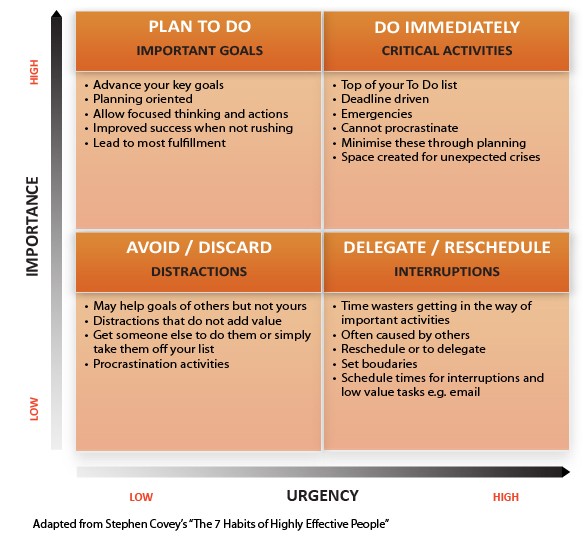Five Steps to Taking Control of Your Priorities

If you’re like many association leaders, you’re probably feeling the stress of keeping your board, your volunteers and your staff happy at work, not to mention your family happy at home, and your community organizations satisfied with your commitment level. Add to that a desire to eat better and stay in shape while traveling a great deal and you will probably be confronted with the lack of time to do everything on your list.
I hear this sense of dread daily from friends, clients and family members. Most of us do. You know you’ll feel so much better when you get control of your priorities. But, how do you really do it?
Chances are, you’ve read every self-help book on the shelves, attended leadership seminars, and also been given lots of tips and advice about how to deal with time stress—LOTS! But, you also know how this story normally ends. Your new attitude works well for a few days, maybe even a week or two. Then something unexpected happens and all your good intentions fall by the wayside.
The methods for managing one’s time effectively are well known and can be effective. But, the key ingredient that is normally forgotten is commitment. You need to commit to sticking with the approach and giving it a chance to become the way you work, rather than just another task. For highly effective leaders, that’s the point at which you no longer have to think about focusing on the right things and the focus just comes naturally.
Subscribe to Association Adviser eNews and receive stories like this in your inbox monthly. |
During my career, I’ve faced many of the same challenges you have, especially during a long stint I had as an international road warrior. I was away from home three out of every four weeks and had multiple areas of responsibility. This forced me to look at how I managed my workload and how I defined my priorities. Over the past few years, I’ve helped my clients use this approach to feel more in control and to increase their own success and business performance.
A quick review of the approach
The approach I’m talking about is based on Stephen Covey’s work in his landmark 1994 book, “The 7 Habits of Highly Effective People.” I’m sure many of you have read it—or at least put it in your “required reading” pile. But have you really read it?
As many of you might guess, the first step is not just making a realistic to-do list, but identifying and ranking the priorities on your to-do list.
Your priorities reflect the impact that an activity has on your goals and how urgent that activity is. Goals can be business or personal, and the greater impact a task has on these objectives the more important it is. Combine this with urgency of the task to determine the priority level. The fewer items that are urgent, the greater control you will have.
Covey’s second element helps you reduce the number of urgent items on your list by finding time to be proactive.
The idea is to make time for the higher priorities (aka your “big rocks”) before you fit in lower priorities (aka your “pebbles and sand”) into the fixed amount of time “jar” that Covey introduced.
Lessons learned for the road
In my road warrior role (chief HR officer for a global business) one of my big goals was to help highly talented people at our organization perform to the best of their potential. I realized it was essential for me to help our business leaders understand our staff’s capabilities better and to align the organization structure with our leaders’ strengths and personal drivers.
I prioritized my time so I could spend the bulk of my day working with our managers and embedding a culture that gave people the opportunity to thrive. There were urgent things that I had to deal with—a key person resigning or a new acquisition to be integrated. By ensuring that we had the right HR team and structure in place, I could attend to these unplanned urgent needs directly if they were important to my goals. If not important to my goals, then I learned to be comfortable having others pick up the slack.
As you continue to read this article or watch a related segment on Association Adviser TV, you will start to decide what goes into your own jar.
Let’s build your plan together now in five simple steps:
Step 1: List all the things you need to do today.
I expect that this was fairly simple to do. Does it feel overwhelming? Do you think you can get it all done? You know that you will need to prioritize these. Rather than procrastinating or doing this based on what others expect of you, let’s start making more considered choices.
Step 2: Determine the importance of each item on your list.
This step is based on your goals. You decide what your goals are. They could be very personal, they could be business or career goals or they could be family goals. Importance reflects the impact that a task has on your goals. The larger the impact and the more direct the impact, the more important that task becomes.
Your rewritten to-list should now show the items ranked in order of importance from highest to lowest.
Step 3: Rank the urgency of each item in a second list.
Urgency reflects the level of attention demanded by each item. This attention each item gets can be self-imposed (e.g., we have a preferred schedule or it’s part of a deadline we have set) or it can be imposed by others (e.g., you have to pick your child up from school at a set time or your boss has scheduled a meeting at a specific time). As you go through this step, notice the items that keep showing as “urgent.” Could you make them less urgent by making a change—rescheduling, delegating, pre-planning so that it’s not at the last minute, etc.?
Step 4: Combine your importance ranking with your urgency ranking in a matrix.
Draw an empty version of the matrix in Fig. 1 below onto a piece a paper and transfer the ranking of your two lists to this. You now have a visual showing which of the four quadrants your tasks fall within. Each quadrant has a level of priority and reflects the size of the “stones” you will want to get into your time jar.
Figure 1—How to interpret and use the Importance/Urgency Matrix

Step 5: Allocate your time according to your completed matrix.
Start by allocating time to the items in Quadrants 1 and 2—those with a higher priority. The fewer urgent items you have, the less stressed you will be. You can reduce the number of urgent items by getting rid of things that are considered “urgent, but not important” and being more pro-active about those items that are truly important.
How do you feel about the outcome for your day now? Do you feel more in control? Are you clearer about what you need to do first? Now imagine how you will feel if you do this a week in advance. You will have more opportunities to make many urgent items less so. You will be able to more time to allocate to those important items that have the biggest impact on your goals.
Conclusion
Now you’ve determined today’s priorities, your challenge is to stick to them.
This doesn’t mean your priorities are fixed, that crises or new priorities won’t come up. It means you need to be strong enough to keep non-priority tasks from taking over again. You will need to say “no” to others from time to time.
These tools are simple and if used consistently, you will avoid being overwhelmed and stressed. With practice you will automatically and quickly evaluate all demands on your time with two simple questions—“Is it urgent? Is it important?”
About the Author
Gavin Pommernelle is the founder of Talent Driven Value LLC, where he coaches leaders and develops talent solutions with local and international businesses and not-for-profit organizations that are experiencing changes in complexity, business evolution or management. Gavin is a board member of VolunteerSquare.com helping bring volunteers and community needs together across Fairfield County, Conn. In his global corporate social responsibility experience, he led programs that brought sustained benefit to local communities, such as a highly innovative sponsorship event for the Arts Council of New Orleans post Hurricane Katrina and a vocation-training program for underprivileged teenagers in Vietnam. Gavin can be contacted at [email protected].

